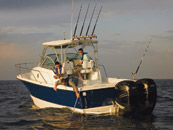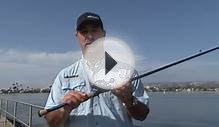
 a better term... Nearly all this country’s best non-freshwater fishing venues are only partially salty. In addition, some of the most prized sport fishing species-salmon, steelhead trout, shad, and striped bass-are anadromous-they breed in fresh water, invest section of their life when you look at the sea, after which move back once again to fresh-water to spawn.
a better term... Nearly all this country’s best non-freshwater fishing venues are only partially salty. In addition, some of the most prized sport fishing species-salmon, steelhead trout, shad, and striped bass-are anadromous-they breed in fresh water, invest section of their life when you look at the sea, after which move back once again to fresh-water to spawn.
Seawater or saltwater is a general term for water with a substantial focus of dissolved salts and solids, usually significantly more than 30 parts per thousand (ppt). Saltiness varies extensively from location to destination and over time. Marlin, tuna, sharks, and bluefish are preferred seawater types.
Brackish Water Fishing
Brackish liquid has even more dissolved salts and solids than freshwater, it is less salty as seawater and can even result from mixing freshwater and seawater in estuaries including the Chesapeake Bay or Puget Sound. For recreation anglers, brackish seas hold a range of fishing opportunities. The most crucial brackish water habitats tend to be estuaries, where streams meet up with the sea.
Brackish water has actually between 0.5 and 30 grms of salt per liter, or higher generally 0.5 to 30 ppt, a variety of saltiness rather than a correctly defined condition. The salinity of many brackish surface waters varies significantly as time passes and length. Heavy rains inland and upriver can send a “slug” of freshwater coursing down the duration of an estuary, changing the salinity along the way. Prolonged drought may have the reverse result.
The definition of freshwater refers to systems of liquid having reduced levels of dissolved salts also dissolved solids, often lower than 0.5 parts per thousand (ppt) of salt. Trout, bass, crappie, pickerel, walleye, and muskie, among various other popular recreation types, frequently live-in freshwater.
The kinds of fishing which you decide to try, combined with the venues you decide on, determine the gear that you'll require. What realy works in a single place, for example species, may well not work down the bay, within the coastline, or even for a different sort of seafood. Fly fishing for false albacore within the browse in vermont calls for different gear than trolling for stripers regarding the Pacific Coast or casting for redfish on a Gulf bayou.
Volumes have now been, and are still becoming discussed choosing marine fishing gear. While saltwater fishing gear resembles freshwater equipment, there are certain standard distinctions. Saltwater gear tends to be thicker and much more durable. The material components tend to be addressed to resist corrosion. Irrespective the kinds of fishing you attempt to the seas you frequent, particular fundamental requirements hold true.
Fishing Rods, the Essential Appliance
In its essence, a fly fishing rod is a stick accustomed dangle a sequence that terminates in a hook regularly get seafood. A modern fly fishing rod is generally a more advanced casting device fitted with range guides and a reel for storing range. Fishing rods differ thick, flexibility, and size, and can be 2 to 20 feet very long. The longer the pole, the more the mechanical benefit in casting.
a fly rod also stretches the angler’s reach and influence. Necessary to casting and showing the bait or lure to entice fish, the rod absorbs the shock of a fish striking and assists set the hook and play and secure the seafood. Rods also keep the reel and guide the range on and off the spool.
Rods are generally fitted with guides, line loops that direct the line towards the tip-top, the guide near the top of the pole. Grips would be the an element of the pole that you hold in your hand, typically manufactured from artificial EVA foam, or cork on good casting rods. The seat holds the reel, generally with a couple type of screw ring or lock product.
Use spin casting rods for energetic types of fishing in which you usually cast and retrieve the bait or appeal. Old-fashioned rotating rods tend to be heavier and suitable for fishing for bigger seafood such striped bass, steelhead, and salmon. Surfcasting rods can operate a lot more than a dozen legs very long, with huge construction to hurl a heavily weighted appeal or bait out beyond the surf’s breakers. Fly fishing rods tend to be making an appearance inside marine environment. Lengthy, thin, flexible, and lightweight, these are typically made to throw flies, frequently streamers in marine venues.
Surfcasters might need super-tall poles of 15 foot or maybe more, while trolling for huge tuna or other big online game seafood calls for a reduced, stiffer pole, maybe not appropriate casting. Many spinning and casting rods range between 5.5 to 7.5 feet. Fiberglass is one of economic material for fishing rods; graphite is lighter, stiffer and much more sensitive but in addition pricier. Regardless the kind of fishing you prefer, suit your rod, reel and tackle to improve your chances of making a catch. For newbies and casual anglers, a prepackaged mix of pole, reel, and tackle lets you spend more time in fact fishing.
Fishing Reels
Fishing reels shop, deploy, and access fishing range. They increase technical advantage to manage powerful fish and also have a “drag” system used to pressure a fish during a fight. The initial American fishing reel had been devised around 1820, a bait caster that rapidly shot to popularity. Bait casting reels store line on a revolving spool and generally are attached over the rod. Their spools sit perpendicular to your rod and range in proportions from small to massive multi-speed offshore saltwater reels, evaluating many pounds. They require a little more method whenever casting to prevent backlash and tangled outlines.
Spinning reels are the easiest for most anglers to use and therefore are suitably robust for midweight marine fishing. They have a set spool set below and parallel with all the rod and had been initially built to throw artificial flies and lures to trout and salmon. The fixed spool solved the backlash issue and soon after models proved durable adequate to deal with bigger baits and larger captures. Spinning reels tend to be an excellent option for light tackle and easy to use by everyday and starting anglers.
The spin cast reel details the bait casting reel’s backlash and lowers the range twist and snaring sometimes experienced with spinning reels. Usually mounted above the pole, the spin cast reel—sometimes called a closed face spinner-is fitted with a metal cup and an external nose cone enclosing the fixed, parallel spool. Primarily a freshwater tool, “closed-face spinners” may show up mainly casting from piers and into brackish backwaters.
Travel casting reels tend to be not at all hard and serve more to store the line than to mechanically help playing the seafood.
Irrespective the type, reels designed for marine usage are pricier because they make use of corrosion-resistant products including anodized aluminum, protected stainless steel, or bronze bearings and forged aluminum spools. High quality reels also make use of sealed baseball bearings for a smoother action. A rod and reel work together to create a method. Choose a reel is to match the pole you’ll be using. Buying a rod and reel combo are a wise shortcut to getting yourself on the water getting fish.
RELATED VIDEO












